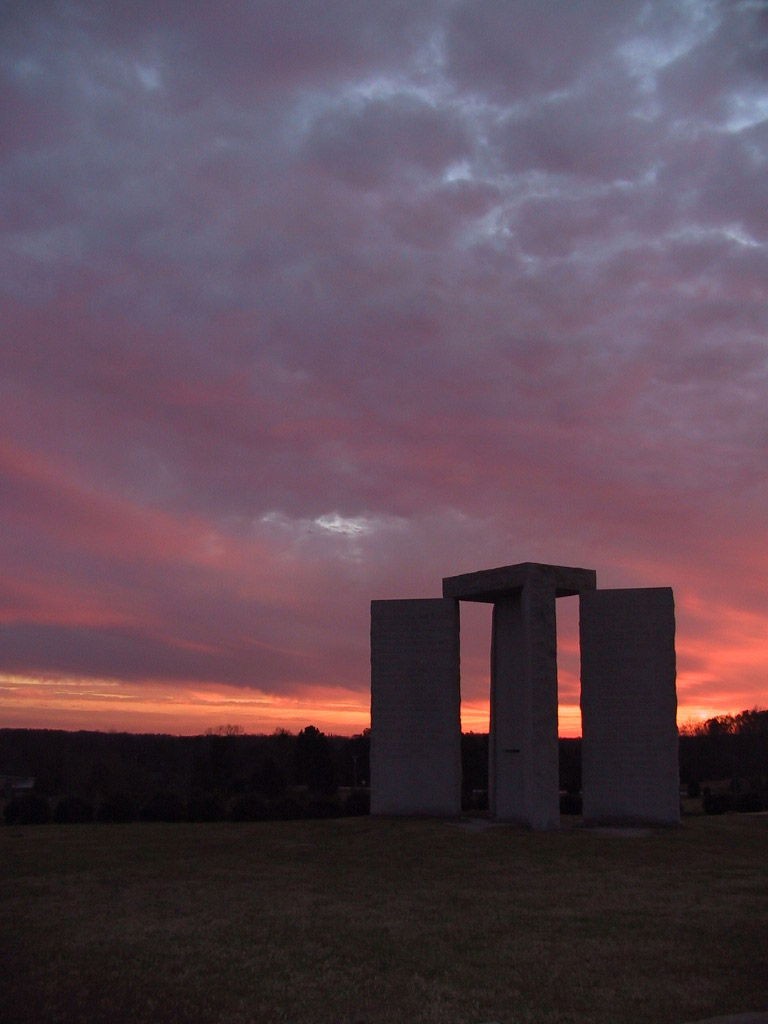From 1980 until their destruction in 2022, the Georgia Guidestones stood as a unique and controversial granite monument in Elbert County, Georgia. Often referred to as the American Stonehenge, these towering stones sparked curiosity, debate, and conspiracy theories. But What Are Guide Stones, and what made these particular ones so significant?
The Georgia Guidestones were erected on the highest point in Elbert County, in the northeastern Piedmont region of Georgia. Unveiled on March 22, 1980, they bore a striking resemblance to Stonehenge, serving as a celestial clock that marked the passage of time. However, unlike Stonehenge, the Guidestones featured a written message for humanity. The stones were arranged in an “X” pattern, with each line oriented toward specific points in the moon’s annual rotation around the Earth.
The story of the Guidestones begins in the summer of 1979. A man using the pseudonym R. C. Christian approached granite firms in Elberton, seeking a company to bring his monument design to life and a suitable location for its construction. Christian, who claimed the pseudonym represented his beliefs and those of the organization funding the project, never revealed his true identity or the organization’s name. He selected Elbert County for its abundant granite, rural setting, mild climate, and the fact that some of his ancestors had lived there.
Joe H. Fendley Sr., president of the Elberton Granite Finishing Company, was surprised by Christian’s plan to construct a massive granite monument with inscriptions offering guidance for humanity to enter an “age of reason.” Christian also shared his hope with Wyatt C. Martin, president of Granite City Bank, that other conservation-minded groups would eventually add more stones, forming an outer ring around the central structure. He emphasized his desire for the monument to be placed in a rural location, away from crowds and tourists.
Fendley’s team crafted the monument from four massive blue granite slabs, a center stone (the Gnomen stone), and a capstone. The completed structure weighed 119 tons and contained 951 cubic feet of granite. More than 4,000 sandblasted characters and letters, averaging four inches in height, were inscribed on the stones. Christian and Martin chose a five-acre plot in a cow pasture, seven miles north of Elberton and eight miles south of Hartwell, offering a panoramic view to the east and west. The site was near what the Cherokee Indians called “Al-yeh-li A lo-Hee,” or the center of the world. Elbert County owned the land where the Guidestones stood.
The inscriptions on the Guidestones were intended for both present and future generations. The capstone bore the message: “Let these be guidestones to an age of reason,” in Babylonian cuneiform, Egyptian hieroglyphics, Sanskrit, and classical Greek. The four granite slabs, each weighing over 42,000 pounds and standing over sixteen feet tall, presented ten “guides” for humanity in eight languages: Arabic, Chinese, English, Hebrew, Hindi, Russian, Spanish, and Swahili. These messages focused on governance, population control, environmental stewardship, and spirituality.
Some of the guides were straightforward, while others were open to interpretation, leading to controversy and debate about their hidden or intended meanings. The monument was vandalized multiple times and became the center of numerous conspiracy theories, particularly those related to population control and internationalism. The ten principles outlined on the Guidestones were intended to ensure humankind’s survival:
- Maintain humanity under 500,000,000 in perpetual balance with nature.
- Guide reproduction wisely — improving fitness and diversity.
- Unite humanity with a living new language.
- Rule Passion — Faith — Tradition — and all things with tempered reason.
- Protect people and nations with fair laws and just courts.
- Let all nations rule internally resolving external disputes in a world court.
- Avoid petty laws and useless officials.
- Balance personal rights with social duties.
- Prize truth — beauty — love — seeking harmony with the infinite.
- Be not a cancer on the earth — Leave room for nature — Leave room for nature.
Beyond the written messages, the Guidestones also had astronomical features. The four upright granite slabs were aligned with the limits of the moon’s migration throughout the year. An eye-level hole in the Gnomen stone pointed towards Polaris, the North Star. A slot in the Gnomen stone aligned the monument with the summer and winter solstices. The Guidestones also functioned as a giant sundial, with sunlight shining through a hole in the capstone onto the southern face of the Gnomen stone at noon.
The controversy surrounding the Guidestones reached a boiling point in 2022. Kandiss Taylor, a Republican candidate for governor, labeled the site “satanic” and pledged to destroy it if elected. This attention on social media reignited interest in the Guidestones among evangelical Christians and conspiracy theorists. In the early hours of July 6, 2022, an explosion partially destroyed the monument. Local and state police found evidence of a bomb and released security footage of the explosion. Citing safety concerns, the Georgia Bureau of Investigation demolished the remaining structure later that day. The investigation into the bombing is still ongoing.
Today, the Elberton Granite Museum in Elberton features a display model of the Guidestones and a short film about their construction. The museum also offers free brochures with information about the Guidestones and their history. Although the physical monument is gone, the questions and debates it sparked continue to resonate, leaving a lasting impact on those who pondered what are guide stones and the messages they conveyed.

